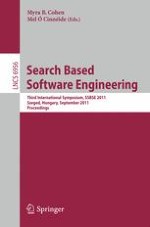This book constitutes the refereed proceedings of the Third International Symposium on Search Based Software Engineering, SSBSE 2011 held in Szeged, Hungary in collocation with ESEC/FSE 2011.
The 18 revised full papers presented together with two invited contributions and abstracts of eight poster presentations were carefully reviewed and selected from 43 submissions. The papers are organized in topical sections on foundations of SSBSE; concurrency and models; requirements and planning; software testing; and comprehension, transformation and scalability.
